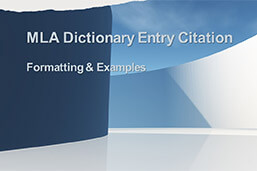
The MLA, Modern Language Association, allows you to easily present definitions, avoiding plagiarism while making your work easy to understand. The MLA dictionary entry citation guide provides a practical, economic structure. It’s one of the most popular options for students and writers alike, particularly in fields related to language.
Definition: MLA dictionary entry citation
The MLA dictionary entry citation format structures online sources in the following order:
- Title of entry in double quotation marks
- The part of speech in italics.
- The definition number in brackets.
- The dictionary name in italics.
- The date you accessed the information
- The database URL
Your Works Cited page should be double-spaced, with page numbers cited as pp. entries should be alphabetized by the author’s last name. When that’s unknown, alphabetize by the title, which should be presented in italics.
MLA dictionary entry citation: Part of speech and definition numbers
You’ll often cite words that can occupy a few different parts of speech and which have several definitions. The MLA dictionary entry citation guide makes room for these variations:
Part of speech
Parts of speech tell you which job a word does in a sentence. If the word you’re citing can be used as two or more parts of speech, include the exact definition in your title of entry along with the abbreviated part of speech in italics and double quotation marks. The MLA dictionary entry citation guide has abbreviations for all eight parts of speech. These are denoted between the word and its definition in most dictionaries.
| Part of Speech | Abbreviation |
| Noun | N. |
| Pronoun | Pron. |
| Verb | V. |
| Adjective | Adj. |
| Adverb | Adv. |
| Preposition | Prep. |
| Conjunction | Conj. |
| Interjection | Interj. |
The MLA dictionary entry citation guide requires a part of speech to be used in all definitions.
Definition number
Many words have more than one definition, so most dictionaries list each one numerically after their parts of speech. If your cited word has only one definition, there’s no need to cite the definition number with your MLA dictionary entry citation.
MLA dictionary entry citation: In-text citations
The in-text MLA dictionary entry citation structure includes the title shortened to the word in quotation marks. If you want to refer to a particular definition of the word within the dictionary entry that you are citing, include the definition number as shown in the example.
MLA dictionary entry citation: Print dictionary
A print MLA dictionary entry citation should be structured in order of:
- Title of entry in double quotation marks.
- Part of speech in italics.
- Definition number in bracket.
- Dictionary name in italics.
- The edition.
- The publisher
- The year of publication
- The page number
Most publishers include the copyright statement and publication date behind the title page.
If you’re citing a definition, your structure should include the word, part of speech in italics, and the definition number if the word has several definitions. The dictionary name should be cited in italics, followed by the year of publication.
✘ Avoid these common mistakes:
- Using a library database. These sites usually offer a dedicated URL that becomes inactive after the session.
- Miscapitalizing your title entry. MLA dictionary entry citations use AP stylebook capitalization rules.
- Forgetting to add a reference listing for in-text citations.
- Including honorifics in in-text citations. Only the surname of the author should be included.
Niche publications such as theology or business dictionaries often have authored entries, so they need to be incorporated into the MLA dictionary entry citation as:
| MLA dictionary entry citation | Author’s last name, first name, editor. “Title of Entry.” Title of Dictionary, Edition, Publisher, Year, p. Page number. |
| Works Cited | Shorter Oxford English Dictionary, 3rd ed., Oxford University Press, 1998, p. 336. |
| In-text citation | (Butterfly) |
If your source has multiple authors, the first author should be listed with their last name first. The second and subsequent authors should be listed by first name first. If each entry has its own author, list the applicable author first:
| MLA dictionary entry citation | Author last name, First name. “Entry Title.” Dictionary Name, edited by Editor first name Last name, Edition, Publisher, Year, URL. |
| Works Cited | Butterfly, Joana. “Citation.” Shorter Oxford English Dictionary. Edited by Ivana K. Malta, summer 2019 ed., Oxford University Press, 2019, www.oxford-english-dictionary.com/citation. |
| In-text citation | (Butterfly, sec. 2.3) |
FAQs
If you’re using a language dictionary definition merely to clarify the meaning of a word, a citation is generally not required. If that definition is a primary source, it’s best to cite it.
Your citation should be structured as “Word, Part of speech. (Definition number).” Dictionary Name, Year, URL.
The Oxford English Dictionary is seen as the gold standard of the English Language, but many students prefer the user-friendliness of Collins.
